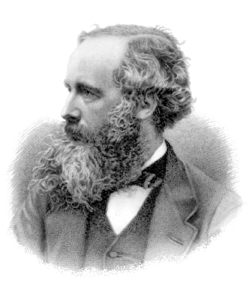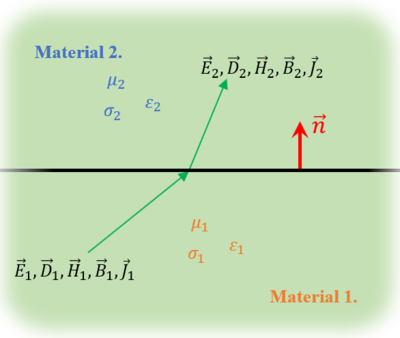Lecture 1.
|
Basics of Electromagnetics / Static Magnetic and Electrostatic Field | |
|
Instructor
|
Teaching Assistants:
|
Contents
Basic Principle of Electromagnetic Theory
Electromagnetic theory forms the foundation of different physical fields and phenomenon. It is used to explain many wave phenomena like propagation, reflection, refraction, diffraction and scattering. In the following, we shall review the fundamental aspects of the electromagnetic theory.
Maxwell's Equations
The physics of electromagnetic field is described mathematically by the Maxwell's equations[1] [2]. These equations can be written in differential as well as integral forms. For time-varying electromagnetic fields, the Maxwell's equations are as follows.
Differential Form
[math]\nabla\times\vec{H}(\vec{r},t)=\vec{J}(\vec{r},t)+\frac{\partial D(\vec{r},t)}{\partial t}[/math]
Maxwell-Ampére law,
[math]\nabla\times\vec{E}(\vec{r},t)=-\frac{\partial \vec{B}(\vec{r},t)}{\partial t}[/math]
Faraday's law,
[math]\nabla\cdot\vec{B}(\vec{r},t)=0[/math]
Gauss's law (magnetic),
[math]\nabla\cdot\vec{D}(\vec{r},t)=\rho(\vec{r},t)[/math]
Gauss's law (electric),
where:
- [math]\vec{H}(\vec{r},t)[/math] is magnetic field intensity in [A/m];
- [math]\vec{E}(\vec{r},t)[/math] is electric field intensity in [V/m];
- [math]\vec{B}(\vec{r},t)[/math] is magnetic flux density in [Wb/m[math]^2[/math]];
- [math]\vec{D}(\vec{r},t)[/math] is electric flux density in [C/m[math]^2[/math]];
- [math]\vec{J}(\vec{r},t)[/math] is electric current density in [A/m[math]^2[/math]];
- [math]\rho(\vec{r},t)[/math] is electric charge density in [C/m[math]^3[/math]].
The field quantities are depending on space [math]\vec{r}[/math] and on time [math]t[/math], therefore in the following a shorter notation will be left.
There is an important relationship between the variation of the current density [math]\vec{J}[/math] and the charge density [math]\rho[/math], the so-called current continuity equation (also called charge conservation law). This law is coming from the divergence of first Maxwell’s equation:
- [math]\nabla\cdot(\nabla\times\vec{H})=\nabla\cdot\biggl(\vec{J}+\frac{\partial D}{\partial t}\biggr)=\nabla\cdot\vec{J}+\frac{\partial}{\partial t}\nabla\cdot\vec{D}[/math].
The left-hand side is equal to zero according to the identity [math]\nabla\cdot(\nabla\times\vec{v})\equiv 0[/math], for any vector [math]\vec{v}=\vec{v}(\vec{r},t)[/math] and the second term on the right-hand side can be rewritten by applying electric Gauss's law. Finally the current continuity equation has the form
- [math]\nabla\cdot\vec{J}+\frac{\partial \rho}{\partial t} = 0[/math].
This equation means that the variation of current and charge distribution according to space and time is dependent on each other.
Integral Form
The integral form of Maxwell's equations can be derived from their differential form by employing Stoke's theorem and Gauss's theorem. The integral form is given by
[math]\oint_{\scriptstyle l}\vec{H}(\vec{r},t)\cdot\text{d}\vec{l}=\int_{\scriptstyle A}\vec{J}(\vec{r},t)\cdot\text{d}\vec{A}+\frac{\partial}{\partial t}\int_{A}\vec{D}(\vec{r},t)\cdot\text{d}\vec{A}[/math]
Maxwell-Ampére law,
[math]\oint_{l}\vec{E}(\vec{r},t)\cdot\text{d}\vec{l}=-\frac{\partial}{\partial t}\int_{A}\vec{B}(\vec{r},t)\cdot\text{d}\vec{A}[/math]
Faraday's law,
[math]\oint_{\scriptstyle A}\vec{B}(\vec{r},t)\cdot\text{d}\vec{A}=0[/math]
Gauss's law (magnetic),
[math]\oint_{\scriptstyle A}\vec{D}(\vec{r},t)\cdot\text{d}\vec{A} = \int_{\scriptstyle V}\rho(\vec{r},t)\text{d}V[/math]
Gauss's law (electric).
The Maxwell's equations are general and hold for fields with arbitrary time dependence in any medium and at any location.
Constitutive Relations
Equations which describe the relationship between field quatities called constitutive relations. Constitutive relations are generally nonlinear, that is the permeability [math]\mu[/math], the conductivity [math]\sigma[/math] and the permebility [math]\varepsilon[/math] depend on the appropriate field quatities,
- [math]\mu=\mu(\vec{H},\vec{B})[/math],
- [math]\sigma=\sigma(\vec{E},\vec{J})[/math],
- [math]\varepsilon=\varepsilon(\vec{E},\vec{D})[/math].
This can be written in another way
- [math]\vec{B}=\mathfrak{B}(\vec{H})[/math],
- [math]\vec{J}=\mathfrak{J}(\vec{E})[/math],
- [math]\vec{D}=\mathfrak{D}(\vec{E})[/math],
where [math]\mathfrak{B}(\cdot)[/math], [math]\mathfrak{J}(\cdot)[/math] and [math]\mathfrak{D}(\cdot)[/math] are operators.
If the material properties are independent of space [math]\vec{r}[/math], they are homogenious, otherwise they are inhomogeneous, [math]\mu=\mu(\vec{r})[/math], [math]\sigma=\sigma(\vec{r})[/math], [math]\varepsilon=\varepsilon(\vec{r})[/math]. Constitutive relations may depend on the frequency of excitation as well, [math]\mu=\mu(f)[/math], [math]\sigma=\sigma(f)[/math], [math]\varepsilon=\varepsilon(f)[/math]. When the constitutive parameters depend on the directions of the applied field, the materials are anisotropic, otherwise they are isotropic. In the anisotropic case the permeability, the conductivity and the permittivity are tensors, [math]\vec{B}=[\mu]\vec{H}[/math], [math]\vec{J}=[\sigma]\vec{E}[/math], [math]\vec{D}=[\varepsilon]\vec{E}[/math], for example
- [math][\mu]=\begin{bmatrix} \mu_{xx} & \mu_{xy} & \mu_{xz} \\ \mu_{yx} & \mu_{yy} & \mu_{yz} \\ \mu_{zx} & \mu_{zy} & \mu_{zz} \end{bmatrix}[/math].
In the most general situation, the constitutive relations depend on all of the above variable, e.g.
- [math]\vec{B}=\mathfrak{B}\{\vec{H},\vec{r},f\}[/math].
Interface and Boundary Conditions
Maxwell's equations along with the constitutive relations my be used to obtain general solution for the electromagnetic problems. To obtain unique solutions, we must enforce the boundary conditions at the periphery of the problem. Additionally, in a mixed media device ([math]\mu_{1}; \mu_{2}; \varepsilon_{1}; \varepsilon_{2}; \sigma_{1}; \sigma_{2}[/math]), continuity conditions at the interface of two media should be satisfied in order to ensure continuity of fields across the interface.
Interface Conditions
The interface conditions between two materials, as shown in figure, prescribe continutity for the tangential component of the electric field intensity,
- [math]\vec{n}\times\left(\vec{E}_{2} - \vec{E}_{1}\right) = \vec{0}[/math].
The surface current density [math]\vec{K}[/math] relates to the tangential component of the magnetic field intensity vector,
- [math]\vec{n}\times\left(\vec{H}_{2} - \vec{H}_{1}\right) = \vec{K}[/math].
The surface current density [math]\vec{K}[/math] is flowing on the surface tangentially to the normal vector unit [math]\vec{n}[/math]. If there is no surface current density on the interface, the tangential component of the magnetic field intensity is continuous,
- [math]\vec{n}\times\left(\vec{H}_{2} - \vec{H}_{1}\right) = \vec{0}[/math].
On the interface of different dielectric materials the normal component of the electric flux density is continuous only if there is no surface charge, [math]\rho_{\scriptstyle A} = 0[/math],
- [math]\vec{n}\cdot\left(\vec{D}_{2} - \vec{D}_{1}\right) = 0[/math],
otherwise the normal component of the electric flux density has a jump on the interface,
- [math]\vec{n}\cdot\left(\vec{D}_{2} - \vec{D}_{1}\right) = \rho_{\scriptstyle A}[/math].
On the interface of different magnetic materials, the normal component of the magnetic flux density must be continuous,
- [math]\vec{n}\cdot\left(\vec{B}_{2} - \vec{B}_{1}\right) = 0[/math].
The charge conservation law yields the continuity of the normal component of the conducting current in the case of eddy current field,
- [math]\vec{n}\cdot\left(\vec{J}_{2} - \vec{J}_{1}\right) = 0[/math],
or generally
- [math]\vec{n}\cdot\left(\vec{D}_{2} - \vec{D}_{1}\right) + \vec{n}\cdot\left(\frac{\partial \vec{D}_{2}}{\partial t}-\frac{\partial \vec{D}_{1}}{\partial t}\right) = 0[/math],
is valid on the interface.
Boundary Conditions
The boundary conditions at the periphery of the device must be satisfied to ensure unique solution. These conditions may be classified as Dirichlet type and Neumann type, homogeneous and inhomogeneous. We shall discuss theses conditions in relation to the solution of the Laplace equation
- [math]\nabla\cdot\varepsilon\nabla V=0[/math],
where the function [math]V[/math] may represent field or potential. The homogeneous Dirichlet boundary condition may be specified as
- [math]V(\vec{r})=0[/math],
on outer surface of problem. This condition translates to [math]E_{\text{tan}}=0[/math] on a perfect electric conductor.
The homogeneous Neumann boundary condition is specified as
- [math]\frac{\partial V(\vec{r})}{\partial n}=\nabla V \cdot \vec{n} = 0[/math],
on outer surface of problem, that is directional derivative of [math]V[/math] along the outward normal [math]\vec{n}[/math] to the boundary equals zero. This condition implies that [math]\partial H/\partial n = 0[/math] on a perfect electric conductor, since normal derivative of [math]H[/math] is proportional to tangential electric field. The boundary conditions are called homogeneous boundary conditions bacause the right-hand side of the equation is zero. The corresponding inhomogeneous boundary conditions are obtained when the right-hand side is not zero, for example,
- [math]V(\vec{r})=\text{constant}[/math];
- [math]\frac{\partial V(\vec{r})}{\partial n}=\nabla V \cdot \vec{n} = \text{constant}[/math].
Electromagnetics Models - Static Fields
In the simplest case the time variation of the field quantities can be neglected, i.e. [math]\partial/\partial t = 0[/math]. Electrostatic fields are usually produced by static electric charges, whereas static magnetic fields are due to the motion of electric charges with uniform velocity (direct current).
Static Magnetic Field
The basic laws of static magnetic fields are Maxwell-Ampére law
- [math]\nabla\times\vec{H}(\vec{r},t)=\vec{J}(\vec{r},t)+\frac{\partial D(\vec{r},t)}{\partial t}\qquad[/math] or [math]\qquad\oint_{\scriptstyle l}\vec{H}(\vec{r},t)\cdot\text{d}\vec{l}=\int_{\scriptstyle A}\vec{J}(\vec{r},t)\cdot\text{d}\vec{A}[/math],
which is related to Biot-Savart law, and the law of conservation of magnetic flux (also calles Gauss's law for static magnetics)
- [math]\nabla\cdot\vec{B} = 0\qquad[/math] or [math]\qquad\oint_{\scriptstyle A}\vec{B}(\vec{r},t)\cdot\text{d}\vec{A}=0[/math].
The vector fields [math]\vec{B}[/math] and [math]\vec{H}[/math] are related through the permeability [math]\mu = \mu_{0}\mu_{r}[/math] (in henries/meter) of the media as [math]\vec{B}=\mu\vec{H}[/math], where [math]\mu_{0} = 4\pi\cdot10^{-7}\tfrac{\text{H}}{\text{m}}[/math] is the permeability of vacuum, and [math]\mu_{r}[/math] is the relative permeability. Also, [math]\vec{J}[/math] is related to [math]\vec{E}[/math] through the conductivity [math]\sigma[/math] (in siemens/meter) of the medium as [math]\vec{J}=\sigma\vec{E}[/math].
In terms of the magnetic vector potential [math]\vec{A}[/math] (in weber/meter)
- [math]\vec{B}=\nabla\times\vec{A}[/math],
because of identity [math]\nabla\cdot\left(\nabla\times\vec{v}\right)\equiv\vec{0}[/math].
Combining Ampere's law, constitutive relation and expression of [math]\vec{B}[/math] gives
- [math]\nabla\times\left(\frac{1}{\mu}\nabla\times\vec{A}\right)=\vec{J}[/math].
Electrostatic Field
The two fundamental laws governing these electrostatic fields are Gauss's law,
- [math]\nabla\cdot\vec{D}=\rho_{\scriptstyle A}\qquad[/math] or [math]\qquad\oint_{\scriptstyle A}\vec{D}(\vec{r},t)\cdot\text{d}\vec{A} = \int_{\scriptstyle V}\rho(\vec{r},t)\text{d}V[/math],
which is a direct consequency of Coulomb's force law, and the law describing electrostatic fields as conservative,
- [math]\nabla\times\vec{E}=\vec{0}\qquad[/math] or [math]\qquad\oint_{l}\vec{E}(\vec{r},t)\cdot\text{d}\vec{l}=\vec{0}[/math].
The vector fields [math]\vec{D}[/math] and [math]\vec{E}[/math] are related as [math]\vec{D}=\varepsilon\vec{E}[/math], where [math]\varepsilon=\varepsilon_{0}\varepsilon_{r}[/math] is the dielectric permittivity (in farad/meter) of the medium, where [math]\varepsilon_{0} = 8.854\cdot10^{-12}\tfrac{\text{F}}{\text{m}}[/math] is the permittivity of vacuum and [math]\varepsilon_{r}[/math] is the relative permittivity. In terms of the electric scalar potential [math]V[/math] (in volts), [math]\vec{E}[/math] is expressed as
- [math]\vec{E}=-\nabla V\qquad[/math] or [math]\qquad V = -\int\vec{E}\cdot\text{d}\vec{l}[/math],
because of identity [math]\nabla\times\left(\nabla V\right)\equiv\vec{0}[/math].
Combining Gauss's law, constitutive relation and expression of [math]\vec{E}[/math] gives Poisson's equation
- [math]\nabla\cdot\varepsilon\nabla V=-\rho_{\scriptstyle A}[/math],
or, if [math]\rho_{\scriptstyle A} = 0[/math], equation becomes Laplace's equation
- [math]\nabla\cdot\varepsilon\nabla V=0[/math].

